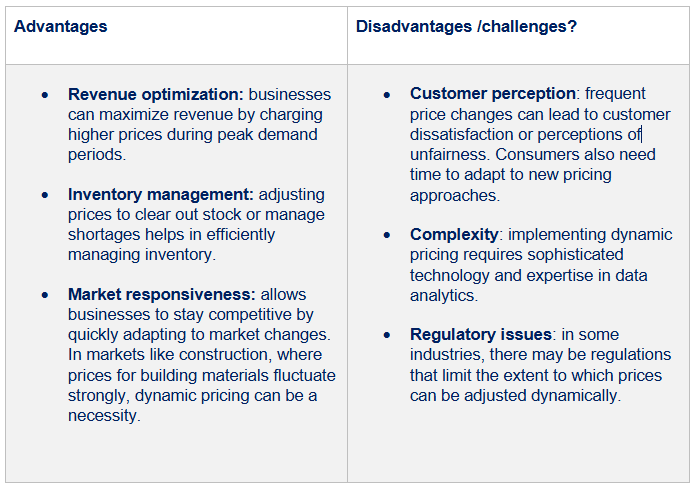
Article
How dynamic pricing is changing the marketplace
Prices that vary with the time of day, market demand, and even weather conditions? That’s (the reality of) dynamic pricing. From airlines to e-commerce, the dynamic pricing model is transforming industries across the board. Explore how it can help you better meet customer needs and maximize revenue.
Introducing dynamic pricing
Dynamic pricing means regularly adjusting the price of your products or services in response to shifting market conditions. Those could be fluctuations in demand and supply, or factors like expiration dates or competitor discounts. Retailers placing ‘reduced price’ stickers on fresh salads that are nearly out of date? That’s an example of dynamic pricing.
Elements of price variations
Businesses use advanced algorithms and data analytics to monitor and analyze factors such as customer demand, competitor pricing, inventory levels, and market conditions. In a flexible pricing model, you can the adjust prices frequently and flexibly, often multiple times a day, to reflect the current market situation. Prices may also vary based on different customer segments, such as loyalty status, purchasing history, or geographic location. And then there are external factors to be considered as well, like seasonality, or even weather conditions.
Dynamic pricing has been around for ages in certain industries:
- Airlines and hotels: prices for flights and hotel rooms fluctuate based on demand, booking time, and availability.
- Ride-sharing services: companies like Uber use surge pricing during peak demand times or in high-demand areas.
- E-commerce: online retailers adjust prices based on competitor pricing, shopping patterns, and inventory levels.
- Sports and entertainment: ticket prices for events may change based on demand, timing, and seat availability.
Pros and cons for your business(es)
Dynamic pricing is interesting, but complex:

Keep(ing) it transparent
Dynamic pricing models can create fairness issues for consumers due to several factors.
Firstly, there may be a perception of unfairness when prices fluctuate rapidly or unpredictably, making it challenging for consumers to plan their purchases effectively. This unpredictability can lead to feelings of frustration among consumers.
Additionally, dynamic pricing may disproportionately affect certain consumer groups. People with a lower income or less access to technology, for example, may be less able to take advantage of lower prices during off-peak times or may feel unfairly targeted by price increases during high-demand periods.
“If I have 2,000 passengers on a given route and I only have 400 prices, I am missing 1,600 prices. We all have different willingness to pay.”
– Robert Crandall, former CEO of American Airlines, on dynamic pricing
Moreover, there is a concern that dynamic pricing could lead to price discrimination, where certain groups of consumers are charged higher prices based on factors like their location, browsing history, or demographic information.
To address fairness issues in dynamic pricing models and get started with it successfully, these House of Marketing tips can help:
- Make sure your dynamic pricing model is mutually beneficial (it must work both ways, upwards and downwards).
- Be transparent in your communication with customers. When and why do prices change? How can they benefit from it? Explain your pricing algorithms, send invitations to subscribe to price notifications or alerts.
- Implement safeguards to prevent price discrimination and ensure that pricing changes are based on objective criteria. Make sure the factors influencing your price are understandable and predictable.
- Frame it the right way: ‘dynamic pricing’ versus ‘surge pricing’ versus ‘happy hour’ – how you name your pricing model will influence how it’s perceived
It’s up to your company to strike a balance between maximizing profits and maintaining consumer trust and loyalty.
How The House of Marketing helps you with dynamic pricing
Dynamic pricing: how do you go about it? Our approach starts with these 5 steps:
Step #1: Conduct price research and differentiate target groups
Start by understanding the value your product or service offers and assessing the willingness to pay across different customer segments. Some groups are highly price-sensitive, while others are willing to pay a premium. It’s crucial to identify these segments and tailor your pricing strategies accordingly.
Step #2: Identify the key factors for price adjustments
Determine the primary factors on which you will adjust prices. Perhaps you want to provide certain customer groups access to specific products, like lower admission prices for a theme park in the low season? Carefully choose the factors that will drive your pricing strategy, ensuring they are acceptable to your customers.
For example, in some US cities, the Coca-Cola Company installed vending machines that adjusted prices based on weather conditions. The hotter it got, the more expensive a (can of) coke became. This infuriated customers, as the ‘weather’ factor was beyond their control. Other factors are more accepted: consider a bar or restaurant offering Happy Hour prices during less busy times. An approach like this allows customers to influence pricing through their behavior, which is generally more acceptable and appreciated.
Step #3: Run simulations
Conduct simulations to understand the impact of transitioning from static to dynamic pricing. For instance, Uber uses dynamic pricing to increase fares during peak times. This strategy benefits both the company and the customers by ensuring that more drivers are available during high-demand periods, such as events or concerts. By simulating such a price increase, you can predict customer behavior and refine your pricing strategy.
Step #4: Invest in appropriate technology
When implementing intricate dynamic pricing strategies, the tools you choose are crucial. Consider a tent producer operating across two seasons. While simple pricing adjustments can be managed using Excel, specialized dynamic pricing software like SYMSON becomes essential for more frequent changes. Price-scraping modules scan the market for competitor prices, allowing adjustments based on rules like undercutting competitors by a set percentage.
Step #5: Craft effective marketing and communication strategies
It’s essential to convey the benefits and mechanics of dynamic pricing, outlining how customers can leverage it to their advantage. Whether through promotions, loyalty programs, or transparent pricing structures, ensure customers understand how they can access/benefit from lower prices. Avoid terms like “surge pricing,” which may carry negative connotations, and instead opt for more positive and relatable terms like “Happy Hour pricing.” Take inspiration from Disney, who actively informs customers about off-peak pricing periods, fostering transparency and trust.
Is dynamic pricing worth exploring in your company?
Find out with the help of our experts.
